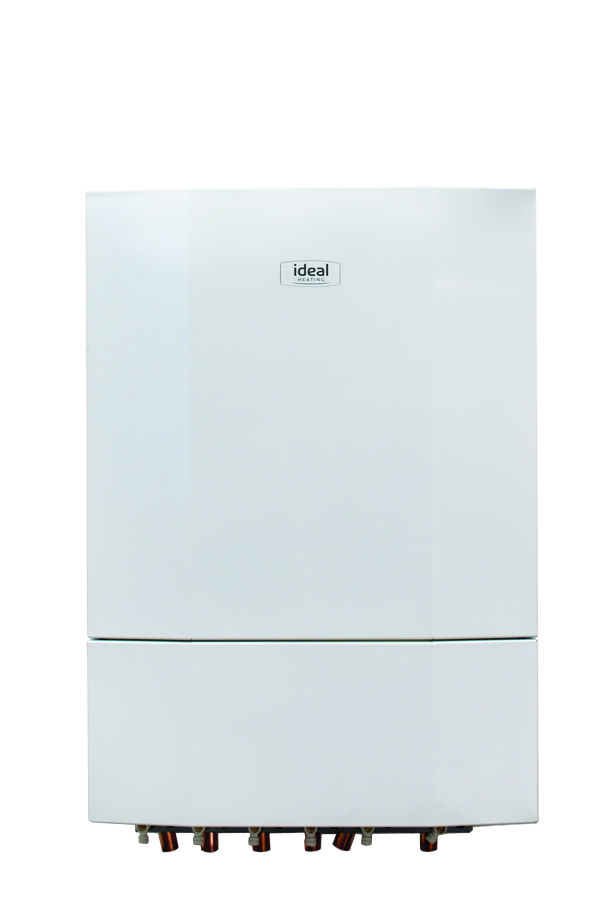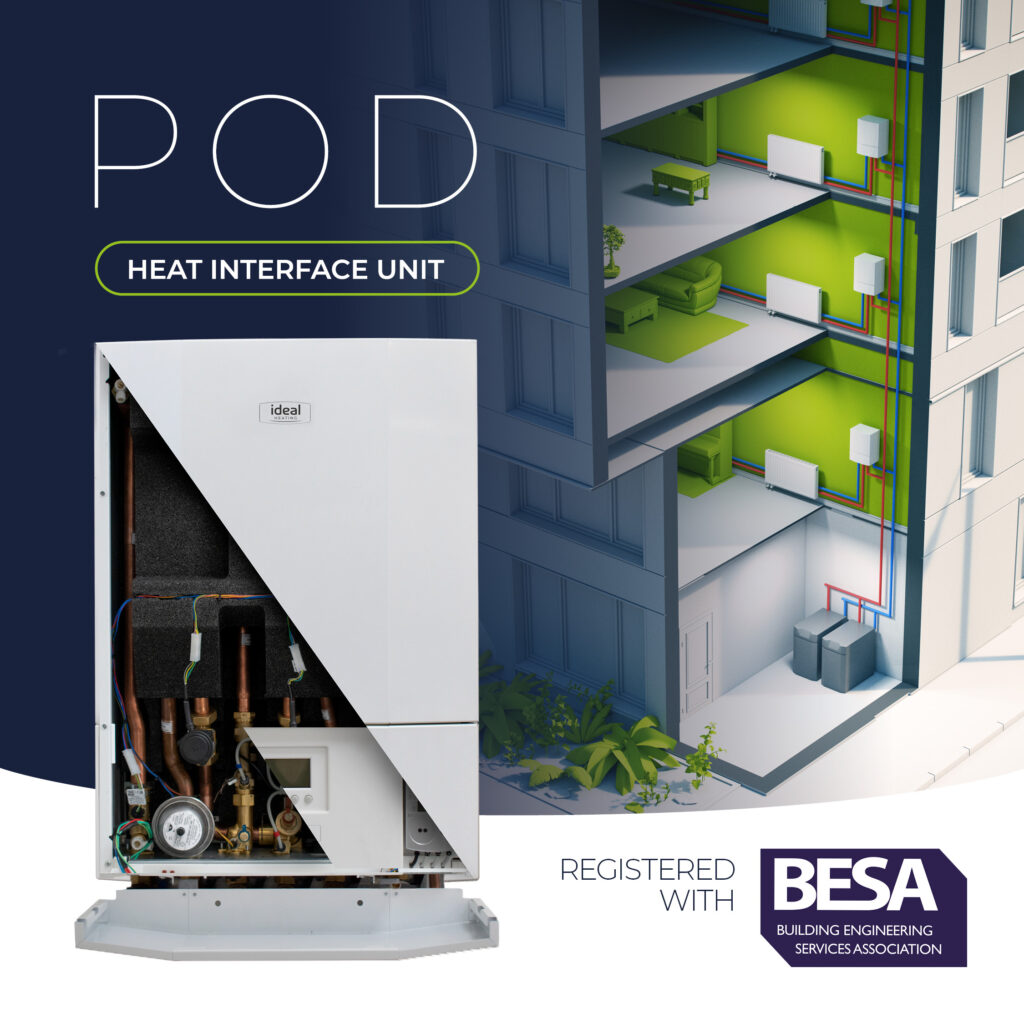
By
Charlie Mowbray, Senior Product Manager, Ideal Heating – Commercial
Heat networks – also referred to as district / communal heating – are a flexible, tried and tested technology that has been safely and effectively heating homes and buildings and generating instantaneous hot water around the world for more than a century. In the UK, heat networks never really took hold as they have in other parts of Northern Europe as we discovered gas in the North Sea and instead placed reliance on natural gas delivered direct to individual homes from the 1960s onwards.
But that’s all set to change.
A transformation of heat generation technology and products in the UK is necessary if we are to reach Net Zero in 2050, and no single type of technology will provide the solution. Heat pumps are seen as one of the major technology types to realise our Net Zero ambitions, along with heat networks that are expected to provide up to 20% of heat in buildings by 2050. And, of course, discussions continue around Hydrogen fuelled appliances.

Components of a heat network
There are three core parts to a heat network: the energy centre, the distribution network, and the heat interface unit (HIU).
The energy centre is the central plant room or dedicated building housing all the equipment responsible for generating or collecting the thermal energy, for storing it or transferring it to the water in the network, and pumping that water around the heat network.
As you would expect, the distribution network consists of all the pipework and any valves or ancillary equipment that distributes and balances the flow across the network. This might be buried in the ground or run up through risers in a building.
At the point of use within the dwelling is the HIU. This is the appliance that transfers the thermal energy from the network to provide heating and hot water for the end user.
HIUs come in indirect or direct models. Indirect HIUs typically have two heat exchangers in the appliance and provide complete separation between the heat network for both heating and hot water. Direct HIUs usually have just the one heat exchanger that may separate heating or hot water from the network; at least one of the services they provide through a direct connection between the network and either the dwelling heating or hot water system. Ideal Heating’s range of POD HIUs are available in both types, with domestic hot water outputs from 30 – 70kW, and feature highly efficient stainless steel brazed plate heat exchangers.

Benefits of a heat network
Heat networks will gladly take their heat input from different sources, making them both flexible and future proof, allowing for gas boilers now but able to readily swap to lower carbon alternatives, such as heat pumps, in the future. With the current government indecision around the future of heating in the UK, this has to be a major benefit!
Heat networks are also a highly scalable solution, regardless of the area covered by the network, or the number of buildings. Furthermore, a single network can encompass dwellings and commercial buildings.
Unlike other types of heating, heat networks can be relatively easily retrofitted into existing housing stock where traditional heating appliances are being replaced, particularly in high density housing, as the fabric of a building or the heating system in the dwelling may not necessarily have to be substantially altered to create the network.
Safety is also another tick in the box for heat networks as there are no flue routes or gas connections to accommodate within a building, for either individual heating appliances or plant.
All these benefits, plus the end-user can receive the same level of comfort and service as they would expect from a traditional heating appliance. In the case of our POD HIUs, they even look like a domestic combi boiler from the outside with similar controls, so are familiar and reassuring to use.
HIU: some key considerations
Whilst the energy centre and distribution network represent the biggest capital costs of a heat network and are the most complex to get right, without the HIU the heat cannot be transferred to each dwelling/building. And in terms of the operating costs and efficiency of the network the HIU plays a vital role, but frequently gets less attention than deserved, sometimes resulting in the specification of a unit that’s not optimised for a particular scheme or application.
To ensure that both the network and the HIUs are operating in harmony, and the heat network is working at its optimum, there are aspects that a specifier or installer should consider when choosing an HIU.
First and foremost, look for a Building Engineering Services Association (BESA) tested HIU. It enables you to see how that HIU performs under specific conditions and provides independently certified levels of performance, rather than solely relying on manufacturers’ claims. All the POD Indirect models are registered on the BESA website.
Further to this, make sure that the performance of the HIU is confirmed for the current operating parameters of your particular network now and, just as importantly, for any future operating parameters. I say ‘future’ because many heat networks may currently operate with gas boilers in the energy centre and a network temperature of 70°C or higher today, but that energy centre may be designed to accommodate conversion to a Low or Zero Carbon energy course in the future such as an air source heat pump which typically operate most efficiently at lower temperatures. The HIU must be flexible enough to work efficiently at this lower network temperature; some cannot, which could be a costly and inconvenient mistake to rectify down the line. The POD is designed to work across a broad range of primary temperatures, from 55°C upwards.
As well as BESA, the Chartered Institution of Building Services Engineers (CIBSE) has invested considerable time and expertise developing their code of practice. CIBSE CP1, Heat networks: Code of Practice for the UK, outlines examples of best practice or minimum standards that you should consider when making your selection. Advice contained within CIBSE CP1 that I feel is particularly beneficial, and that often gets overlooked, includes design considerations for minimising the length of lateral runs in buildings from the main vertical risers; correct specification, thicknesses and installation of insulation on network pipework and pipeline ancillaries (more on this below!); ensuring network pipe sizing is appropriate, not oversized which leads to increased heat losses and contributes to inefficient network operation; and ensuring that the selected HIU consistently delivers low return temperatures for the specific network operating conditions, across a range of loads. There’s a wealth of useful information in this document so be sure to follow the guidance within it.
Backing up the code of practice provided by CIBSE, the Government have produced guidance on the optimisation of heat networks. This series of guidance notes and videos, created with the assistance of Fairheat and Antithesis, sets out practical steps that heat network operators can take to improve the performance of their systems.
Lastly, look at the manufacturer. What level of support do they provide, either at the front-end during design and specification of the network, or once the appliances are in service. And don’t get caught out: check the availability of the appliances and spares parts!
Mistakes to avoid
By referring to CIBSE CP1 and the optimisation guidance, together with the right training and experience, you should be able to deliver an efficient heat network that will reliably deliver heating and hot water for many years to come. That’s the theory at least, but in practice we do see some mistakes being repeatedly made in some aspects of heat networks and HIUs that you really should take great efforts to avoid.
It may seem obvious, but correct use of insulation is key to ensuring that the thermal energy coming from the energy centre of the network is getting to where it is needed, at the HIU, to allow the overall efficiency of the network to be optimised. Yet, we keep seeing the thickness of insulation being reduced during value engineering or construction phases, probably to reduce costs. Even with the correct thickness, the standard of the installation of the insulation can have a dramatic effect on the efficiency of a network. Installers might not appreciate the negative consequences both of these areas can have on the long term operating costs and efficiency of the network.
We’ve mentioned the importance of ensuring the HIU’s performance range when designing and specifying a system, including its ability to function at lower network temperatures to future proof the system. The same issues arise when it comes to the operator deciding to weather compensate the primary flow temperature from the energy centre in a bid to improve efficiency. This normally occurs in the summer months when the heating load is reduced. If the HIUs on that network aren’t designed or specified to operate with a reduced flow temperature, weather compensation can be counter-productive and the HIU may not be able to maintain the same duty for domestic hot water production, or it might cause an increased return temperature from the HIU. So, as before, take time to really consider your choice of HIUs and review the performance data.
Sticking with the temperature theme, it’s very important that you don’t leave a bypass open on the network, or on flushing valves before the HIUs, as this can vastly increase the return temperatures to the energy centre and have a detrimental effect on the network efficiency.
Commissioning of the HIU is where we can encounter a number of errors, all of which can lead to increased return temperatures to the energy centre. The main offender here is a failure to check that the required differential pressure is available at the HIU. Next in line, is incorrect balancing of the heating system to ensure that the required temperature difference is being achieved across each emitter, or across each loop of a dwellings heating system.
Conclusion
Heat Networks and Heat Interface Units are tried and tested technology, and a proven way in which we can help to decarbonise heat in buildings at scale. Ensuring that we realise the best efficiency on the networks, and provide great levels of service and thermal comfort for the resident, requires due diligence, common sense and attention to detail both in the design and installation phases, and high quality appliances.
Ideal Heating – Commercial is the UK’s leading commercial heating manufacturer, with market leading availability.
